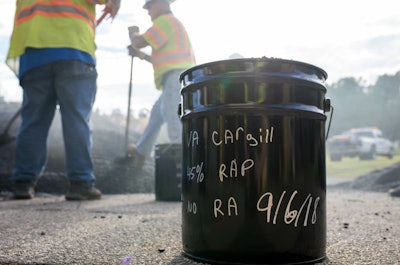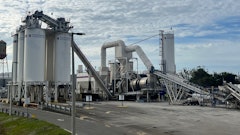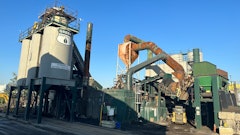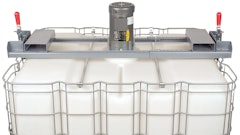
Doing more work with less money seems to be the challenge every pavement asset owner is faced with these days. This means pavement recycling and preservation should be on the mind of every asphalt contractor who wants to remain competitive and retain their work with these agencies and companies.
As pavements continually oxidize and age during their performance life, there is a continual need for work that repairs the durability issues that result over time. Surface pavement rejuvenation products have been used for the last 50 years to help preserve the resiliency of the pavement and delay the need for costly complete resurfacing.
Eventually, these pavements breakdown beyond the point in which a surface rejuvenator can be used and the road must be resurfaced or rebuilt. This leads to an oversupply of milled asphalt. Using a rejuvenator in the mix provides an opportunity to utilize the recycled asphalt pavement (RAP) and increases its value to the road builder.
With the volatile price of crude oil and other virgin materials, there has never been a more opportune time for agencies to consider rejuvenator use both for mix production and pavement preservation. However, most agencies and contractors don’t seem to have a firm grasp on what a rejuvenator is and how they’re used.
Using a Proper Rejuvenator
Whether asset owners are planning to preserve the pavement or recycle the asphalt pavement into a new mixture, a rejuvenating agent needs to be used for many reasons. Asphalt can be characterized as consisting of two phases: a hard and brittle “asphaltene” component dispersed in an oily and resinous “maltene” fraction.”
However, not all rejuvenators are created equal. A good rejuvenator reverses the impact of aging on asphalt performance, properties and durability; protecting the pavement for the future. In order to make sure you’re getting the most out of the rejuvenator you choose, do not use a “softening” agent that does not properly treat  Rejuvenators improve the engineering properties of asphalt mixtures containing high content recycled materials. Adding a rejuvenating agent to a recycled asphalt pavement (RAP) mixture is the best way to increase pavement life while also improving sustainability.Cargill
Rejuvenators improve the engineering properties of asphalt mixtures containing high content recycled materials. Adding a rejuvenating agent to a recycled asphalt pavement (RAP) mixture is the best way to increase pavement life while also improving sustainability.Cargill
The rejuvenation of a recycled asphalt mixture requires rebalancing the bitumen fractions in oxidatively stable and compatible manner. The differences between a softening agent and a rejuvenator involve balancing the correct chemical fractions in asphalt, while improving damage resistance and maintaining that impact with aging. A proper rejuvenation agent will also improve cracking resistance and durability without compromising on rutting resistance.
In the Mix
Choosing the right rejuvenator is important. The use of these recycled materials can not only preserve the environment, they also reduce waste and save money. This means the recycling of asphalt pavement is necessary to maintain roads under current budget constraints. To do this however, contractors need to produce a cost-effective and high-performing mix to construct long-lasting roadways using these materials. These recycled materials tend to be highly aged and can cause potential durability issue for asphalt mixtures and to uphold the quality of recycled mixes, modification is necessary.
Rejuvenators, however, have been receiving attention from the pavement research community because they improve the engineering properties of asphalt mixtures containing high content recycled materials. Adding a rejuvenating agent to a RAP mixture is the best way to increase pavement life while also improving sustainability.
A recent National Cooperative Highway Research Program (NCHRP) study with the Texas A&M Transportation Institute sought to find a new mix design method for asphalt mixtures containing RAP and rejuvenators. Based on their research, the following conclusions were made:
• All rejuvenated binders and asphalt mixtures showed much improved cracking resistance compared to the control binders and mixtures
• Different rejuvenators responded differently to aging
• While rutting performance decreased, the team realized that more careful selection of rejuvenator dosage would be needed to balance cracking and rutting performance
• The team found that a balanced mix design method helped to determine the optimum asphalt content and optimum rejuvenator content in order to meet the mixture rutting and cracking requirements.
Read Next: How to Manage Your RAP from Start to Finish
While further research is needed, rejuvenators have been used in RAP and recycled asphalt shingle (RAS) mixtures with up to 100% RAP without a reduction in pavement performance. This also saves money by incorporating more RAP, reducing the amount of virgin binder and lowering aggregate use in the mix.
Rejuvenators in RAP mixtures are also helping to lower the temperature properties of the mix which allows for an extended compaction zone and paving in cooler temperatures. Today, most state RAP usage rates vary from about 10% to 35%, with the average calling for a mix involving four parts virgin material and one part recycled material. If the agencies allow contractors to double the amount of recycled material in the mix, contractors can double the associated cost savings as well. When this ideal balance is achieved, we not only reduce our environmental impact, we also save money. Adding a rejuvenator will help to not only extend the life of these pavements, but also bring them back to near virgin quality.
On the Surface
While they may not necessarily be the same rejuvenators used in asphalt mixtures, these products can also be used to restore the uppermost layers of asphalt to their youthful, viscous nature, alleviating the effects of years of general wear and tear, UV exposure and oxidation. A proper pavement preservation plan that includes a rejuvenator can also save asset owners money.
The FHWA estimates that spending $1 on pavement rejuvenation before the point of complete failure eliminates or delays spending $6 to $10 on future maintenance or reconstruction costs. $10,000 spent on pavement rejuvenation sounds a lot better than spending $100,000 on a total resurfacing project.
Read Next: What Surface Treatment Option Best Suits your Pavement Maintenance Needs?
The intended use of an asphalt rejuvenator as a surface treatment is to keep good roads in good condition. According to the Asphalt Institute, rejuvenating asphalt emulsions offer three benefits:
1. Increases penetration values and lowers the viscosity of the asphalt binder in the top portion of the pavement, extending the pavement’s life cycle.
2. Seals the pavement against intrusion of air and water, thereby slowing oxidation, preventing stripping and raveling.
3. Increases the durability of the asphalt binder in the top portion of the pavement by improving the balance of chemical fractions of the asphalt binder.
An asphalt rejuvenator penetrates the asphalt well below the surface to chemically revitalize and protect the asphalt binder maltenes. This means rejuvenators restore the components of asphalt lost in the aging process and are designed to penetrate, flux and co-mingle with the existing asphalt binder.
Rejuvenators also reduce raveling, waterproof the surface, rejuvenate and protect surface from UV aging and seal micro cracks before they have a chance to widen, protecting pavement structure from moisture intrusion. They also re-introduce components of asphalt to the asphalt binder. Hairline and micro cracks disappear as the rejuvenator component expands the asphalt droplet as it co-mingles.
Whether preserving old pavement or revitalizing a recycled mix, make sure you’re using the proper rejuvenating agent to get the most out of your asphalt investment.





















